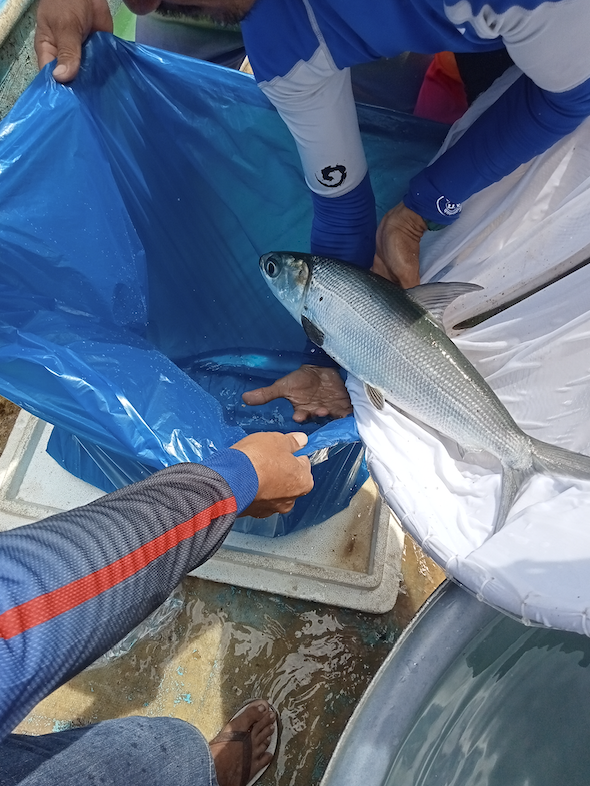
Left Photo: old site of ALT Hatchery. Right Photo: completion of the construction of the new site of ALT Hatchery. (Image credit: UPV Project Team)
The Department of Science and Technology (DOST) through the Collaborative Research and Development to Leverage Philippine Economy (CRADLE) Program funded a project to meet the growing demand for ‘bangus’ fry production.
The University of the Philippines Visayas (UPV), in collaboration with ALT Fisheries and Aquaventures, Inc., has developed innovative technologies aimed at addressing Davao Del Norte’s annual requirement of 88.7 million bangus fry for aquaculture.
The persistent scarcity of bangus fingerlings in aquaculture prompted ALT to establish a hatchery, aiming to supply fingerlings for both their marine fish cages and local producers.
In 2020, the hatchery faced a major setback with substantial deaths of bangus broodstock, leading to a halted production. That year, only 353,500 bangus fry were produced from 7.69 million collected eggs. The hatchery faced various issues such as poor broodstock nutrition, inadequate water exchange, inappropriate waste management, and frequent algal culture collapses, which resulted in mass mortalities and deformities of fry.
To address these challenges, the project, “Sustainable Bangus Fry Production of ALT Hatchery, Panabo City, Davao del Norte,” under the DOST - CRADLE Program was implemented. The project, led by Mr. Fredson Huervana of UPV, collaborated with ALT Fisheries and Aquaventures, Inc. as the industry partner.
The DOST supports projects that provide technological solutions to pressing problems. “This project is testament to the Department’s commitment to providing solutions and opening opportunities through Science, Technology, and Innovation. The increase in milkfish fry survival rate and production will definitely improve the productivity of our aquaculture industry, boosting progress for the Filipinos,” said DOST Secretary Renato U. Solidum, Jr.
This project is monitored by the Philippine Council for Agriculture, Aquatic and Natural Resources Research and Development (PCAARRD) of DOST.
Enhancing the aquaculture production
As hatcheries significantly contribute to the productivity of the aquaculture industry, the project also strives to further improve fry production along with the technical skills of the hatchery staff. The project focused on several key areas to increase milkfish fry production.

Four hundred broodstock were transported from BFAR Tagabuli TOS, Santa Cruz, Davao del Sur to ALT Hatchery, Panabo City, Davao del Norte. (Image credit: UPV Project Team)
Among the results of the project was the improvement of broodstock transport and handling. By employing low salinity and low-temperature techniques without using fish anesthesia, 400 milkfish broodstock were successfully transported with a survival rate of 98-100%. This method reduced stress and increased survival during the four to six-hour transport from Bureau of Fisheries and Aquatic Resources (BFAR) Tagabuli Technology and Outreach Station for Marine and Brackishwater in Santa Cruz, Davao del Sur to the new ALT hatchery in Panabo City, Davao del Norte.
The project also set up a culture system that considers stocking density and larval rearing. The traditional low stocking density of 15 larvae/liter was found to limit production capacity. To address this, the team developed a high-yield culture system with a stocking density of 60–120 larvae/liter, resulting in a 200% increase in productivity. This innovation mitigated issues related to egg disposal due to limited larval tank facilities.
Alternative rotifer diets were also implemented. Algal paste and brewer's yeast were used as alternatives to live algae, which often faced contamination and collapse. This new diet increased rotifer population production by 50%, ensuring a more stable and reliable food source for the larvae.
Lastly, the utilization of probiotics was also key to the improved production. Previous research linked high Vibrio bacterial dominance in culture water to low survival rates of milkfish larvae. To combat this, probiotics were bioencapsulated in rotifers, reducing Vibrio levels in the larvae's gut and increasing their survival by 100%.
Currently, ALT Fisheries operates a new site capable of producing 25-50 million bangus fry annually. With the technological advancements and support from UPV and DOST, ALT aims to enhance milkfish hatchery management, potentially creating more local jobs and boosting the regional economy. The success of these innovations paves the way for high-quality milkfish fry production in Davao del Norte and neighboring provinces, ensuring a sustainable future for the aquaculture industry.

